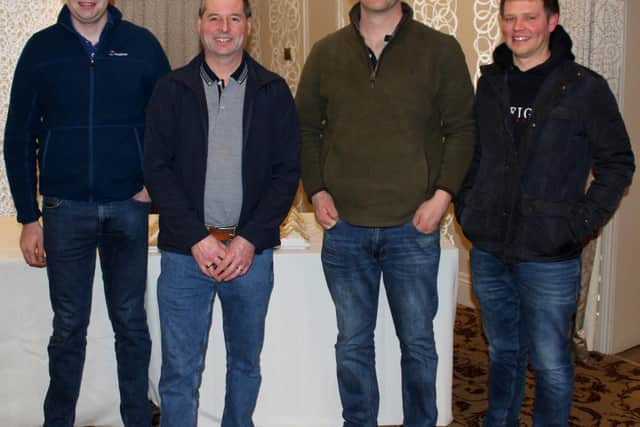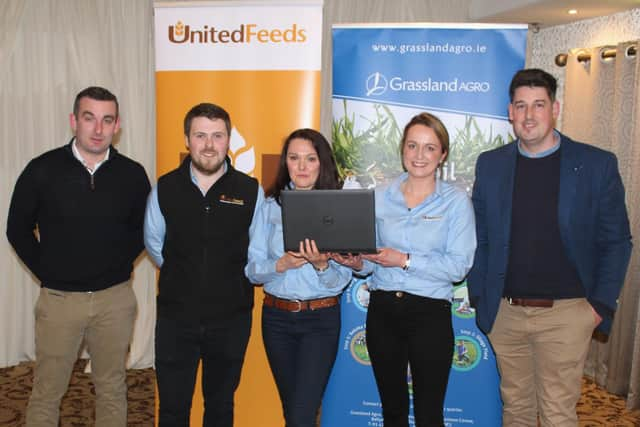Maximising Grass value from soil to silo on NI farms
and live on Freeview channel 276
The event was themed: Maximising Grass value from soil to silo. It provided several speakers with the opportunity to trace the journey that must be taken by farmers to produce high yielding crops of excellent quality silage in the most efficient way possible.
And the good news is that all of this can be achieved in ways that allow the soil to do a lot of the heavy lifting, provided its management needs are met in full.
Advertisement
Advertisement
The meeting took place against the backdrop of silage quality in Northern Ireland having, basically, flat lined over recent years and deteriorated in 2022.


The collated results of all first cut samples taken by United Feeds of 2022 grass silage were presented at the meeting. These confirm the following values:
United Feeds 1st Cut Silage results:
DM – 2002 Average 24.6, 2022 Range 14-52
pH 2022 Average 4.0, 2022 Range 2.9-5.2


Crude Protein – 2022 Average 13.2, 2022 Range 8.6-22
ME – 2022 Average 10.8, 2022 Range 9.6-12.1
D-value – 2022 Average 65.6, 2022 Range 57.5-76
Intake – 2022 Average 91.0, 2022 Range 60-125
NDF – 2022 Average 53.6, 2022 Range 33.3-71.5
Courtesy of her presentation United Feeds’ Edel Madden stressed the need for farmers to maximise the dry matter intakes of their silages, adding:“Grass silage as the most important source of winter feed available in Northern Ireland.
“The performance achieved in terms of both milk output and daily liveweight gain is a product of dry matter intake and the metabolisable energy of the forage.
Advertisement
Advertisement
“Energy intake drives performance: this is why it is important to maximise silage quality.”
John O’Loughlin compared soil to a three-legged stool, with biological, physical and chemical attributes.
And all three criteria must be assessed by farmers, if they wish to maximise their grassland and crop outputs.
John pointed to carbon as being the most important nutrient within all soils.
Advertisement
Advertisement
“This is why the addition of slurries and farmyard manure is so important to all soils,” he said.
“In the past, many farmers may have questioned the value of trucking the likes of slurry to outlying silage ground.
“This thinking has to change. The reality is that the nitrogen, potash and phosphate in the likes of slurry are much more plant active than would be the case when similar nutrients are applied courtesy of artificial fertiliser.
“And this can be readily seen on farms in cases where slurry is only applied to a proportion of a field.
Advertisement
Advertisement
“As the growing season progresses, it will become very obvious that grass output on the part of a field having received slurry will outstrip that which didn’t.
“Research has confirmed that adding carbon to soils will significantly boost crop growth and this fact alone should dictate how farmers actually use slurry within their businesses.”
John went on to confirm that soil compaction is a major challenge on many farms right across Northern Ireland.
Caused, for the most part, by the regular use of heavy machinery on land, the problem significantly reduces the potential of affected soils to drive plant and crop growth.
Advertisement
Advertisement
The Grassland Agro representative continued:“The physical health of every soil is extremely important. In the first instance, farmers must define their targets in this regard and mange their soils accordingly.
“Aeration and sub-soiling are techniques that can be used to improve the physical structure of a soil. But if carried out at the wrong time, they can be totally counterproductive, in terms of the outcomes generated.”
One obvious consequence of soil compaction is the limitation on plant root growth.
“Evidence of this can be easily gauged, simply by using a spade to turnover a sod,” John explained.
Advertisement
Advertisement
“Where compaction has occurred, the root zone will be very shallow.
“But where compaction is not an issue, roots will be seen travelling deep into the ground. Compaction limits plant access to the total nutrient pool within the soil.”
According to O’Loughlin, good soil biology can help to mitigate the impact of compaction. Earthworm activity can, for example, result in large quantities of material being physically relocated within a soil profile on an annual basis.
He added:“There is up to 450kg of labile nitrogen in all soils. The benefits to be gained by mineralising this valuable plant nutrient source are obvious. Improving soil biology helps make this happen.”
Advertisement
Advertisement
Grassland Agro has teamed up with United Feeds to deliver a new ‘Soil Sustainability Programme’ at farm level. The service comprises initial soil testing and analysis; the development of a fertiliser plan; a soil biology assessment, a soil structure assessment;silage measuringplus comprehensive follow-up advice.
Grassland Agro has developed an app for the assessment and scoring of soil and root structure using an infield evaluation. The GrassVESS app can be downloaded at the Apple Store or Google Play store.
United Feeds’ in-house Agronomist, Chloe Kyle, used her presentation to highlight the role of the “third leg on the stool”; that of soil chemistry for driving grassgrowth.
She immediately highlighted the acidic nature of most grassland soils in Northern Ireland as a fundamental obstacle to the efficient use of all crop nutrients, adding:“The aim must always be to match the nutritional needs of a crop in the most effective way possible.
Advertisement
Advertisement
“The starting point in all cases is to soil test and then use the results obtained to devise a nutrient management plan.
“Soil pH drives crop nutrient availability. So determining its initial value and then taking the steps to bring soils into their optimal pH range will underpin all nutrient management programmes.”
Chloe continued:“The optimal pH range for grassland soils in Northern Ireland is between the values of 6.0 and 6.5.
“However, the closer the figure can be brought to 6.5, the better. This is because pH is measured on a logarithmic scale. In other words, the buffering capacity of a soil is greater, the higher its initial pH value.
Advertisement
Advertisement
“Acidification is a process that impacts widely on local soils because of our high rainfall levels and the widespread use of nitrogen fertilisers.”
Approximately 60% of soils tested in Northern Ireland have a pH value below 6.0. Significantly, at a pH value of 5.5 only 77% of the Nitrogen (N) and Potash (K) present in a soil is plant available whilst in relation to Phosphorus this figure is only 48%.
Lime is a natural, cost-effective product that neutralises soil acidity.
As a rule of thumb, applying 0.5t/ac of lime will increase soil pH values by 0.1 of a unit. It takes ground limestone three years to have its full impact. Farmers looking for a quicker response should initially opt for granulated product. Liming will generate a 7:1 return on the investment made.
Advertisement
Advertisement
The United Feeds’ representative outlined a five-point plan, which will allow farmers maximise their fertiliser investment.
This entails: regular soil testing, adhering to an agreed liming programme, balancing phosphate and potash requirements; making best use of slurries and other animal manures and only using artificial fertiliser to top-up crop needs after slurry has been applied.
Chloe added:“A nutrient management plan must be designed to meet the exact needs of a crop. The days are over when fertiliser is applied in a guess work fashion: it’s just too expensive a commodity to use in this way.”
Where fertiliser nitrogen is concerned, United Feeds is recommending the use of protected urea throughout the 2023 season. The company is the exclusive supplier of the SustaiNbrand in Northern Ireland.
Advertisement
Advertisement
Chloe Kyle again: “The urease inhibitor, Agrotain, is specified within SustaiN fertiliser. It is the most efficient product of its kind on the Irish market and the one that is typically used in local research into protected Urea.
“SustaiN is a direct replacement for CAN based fertiliser and should be used as such. This is why SustaiN can be used so effectively throughout the growing season.
“By staying longer in the urea form, the fertiliser can more slowly become available to plants, increasing the chance of being there when needed by the crop. Moreover, SustaiN is better for the environment than both Urea and CAN with validated research proving that the levels of Ammonia and/or Nitrous oxide released to the atmosphere are greatly reduced in comparison”.
SustaiN is available in both nitrogen: sulphur and nitrogen: potash combinations.
Advertisement
Advertisement
The United Feeds Agronomist is also recommending the application of sulphur at a rate of 30 units/ac on first cut silage crops.
This nutrient acts to increase dry matter yields and forage quality. Specifically, sulphur improves nitrogen use efficiency within the plant. Sulphur is the building blocks for protein and will aid CP content and enhance silage quality.
Chloe Kyle concluded:“Sulphur requirements cannot be met by slurry alone. A first cut sulphur application costs approximately £7/ac. However, a 30% reduction in silage yield that could well result from a sulphur deficiency has been valued by AFBI at £72/ac.”
Bryan Buckley, Irish Business Manager – Lallemande Nutrition, provided an overview of the key management priorities that must be implemented to consistently make high quality silage.
Advertisement
Advertisement
The process starts by cutting grass at the optimal growth stage – ie when the grass has a D Value of 72.
Grass should be cut to a height that leaves a reasonable length of stubble behind in the field: 8 – 10cm is recommended.
This approach offers three key benefits: it ensures that the cut grass is resting on a cushion that promotes air flow into the forage; it ensures that soil contamination is minimised while the grass is raked and during pick up: it leaves a strong growing point on the remaining grass plant.
Cut grass should be spread within two hours of cutting in order to boost the wilting process. It should then be picked up within 24 hours of cutting: the aim is to get the sward dry mater up to 30%.
Advertisement
Advertisement
“Silage in a day is the key,” said Buckley. “Grass wilted to 30% dry matter will produce zero effluent.”
He added that forage contamination with the likes of soil and slurry solids is now an increasing issue on Irish farms.
Specifically where slurry is concerned, Buckley advised that it should be thoroughly mixed, diluted with water if necessary and spread prior to rain falling.
In this way, the solid material within the slurry will be quickly washed down to the roots of the grass.
Advertisement
Advertisement
Buckley also recommends the testing of grass prior to cutting. LallemandeNutrition is making test kits available to farmers and contractors through United Feeds representatives.
Criteria to be met prior to cutting include the following parameters: dry matter of grass – 18%; ME value – 12MJ/kg and free nitrates – less than 1,000mg/kg
Every care should be taken to ensile grass properly. The aim is to get the pH within the clamp down to a value 4.0 as quickly as possible. Under these conditions, the silo will remain stable until opened.
The Lallemande representative stressed the need for good clamp face management, once the silo has been brought into use.
Advertisement
Advertisement
“Farmers should target to get across the face five every five days as an absolute maximum,” he further explained.
“A shear grab should be seen as an invaluable tool in this regard. Having its blades sharpened on a regular basis is strongly advised.”
Lallemande Nutrition manufactures the Sil-All range of silage inoculants which are available exclusively in Northern Ireland via United Feeds.